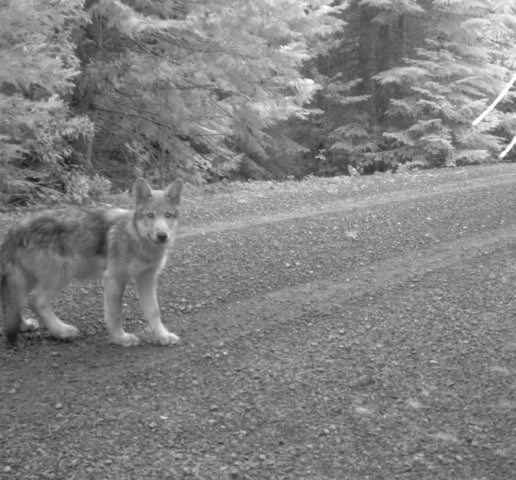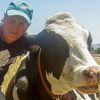
Wolf OR7, the most famous wolf in the west
A new children's book about wolf OR7's 2000 mile trek is a must read for all. In it we read about a young girl's efforts help make OR7 “too famous to kill" and she was successful.
Every now and again a book comes along that moves me all over the place. Noted author Emma Bland Smith's new children's book called Journey: Based on the True Story of OR7, the Most Famous Wolf in the West is one such inspirational and moving work of art. Indeed, the illustrations by Robin James are also magnificent works of art. All in all this book is outstanding and I'm sure audiences of all ages will love it. The book's description reads as follows:
This beautiful picture book follows the journey of a young gray wolf who garnered nationwide attention when he became the first wild wolf in California in almost a century. Using facts recorded by Fish & Wildlife scientists, author Emma Bland Smith imagines the wolf’s experiences in close detail as he makes an epic 2,000-mile trek over three years time. The wolf’s story is interwoven with the perspective of a young girl who follows his trek through the media. As she learns more about wolves and their relationships with humans, she becomes determined to find a way to keep him safe by making him a wolf that is too famous to harm.
I was most fortunate to be able to interview Ms. Smith about her landmark new book.
Why did you write Journey: Based on the True Story of OR7, the Most Famous Wolf in the West?
Although environmental issues have always been of great importance to me, I had never thought much about wolves, their history in the US, or their role in our ecology. Then in 2012, I began to read occasional newspaper reports of this roving wolf, OR7, who had crossed the border and become the first wolf in California since 1924. I read more about how wolves had been almost exterminated from the lower 48 states, and how biologists were trying to bring them back. The controversy over this issue, and the undeserved hostility wolves’ reintroduction was encountering from certain groups, really saddened me. When I learned about the role that several children had played in making OR7 safe from hunters and poachers, I began to think about turning OR7’s story into a children’s book. And when I read that OR7 had, against all odds, met a mate and had a first litter of pups, I knew this could be a book that would really connect with readers. (Biologists never expected OR7 to find a mate and thrive. They were following his epic journey, but since there were no other wolves in the area at the time, they expected him to end his life alone. His tale really is a success story.) As I tell kids on school visits, it’s totally okay to write a book with a sad ending. I wanted this story, however, to have a happy ending. And it does--for OR7, for wolves in general, and for the environment.
What are your major messages?
There are several messages that play out in the book. One is that it is possible for humans to co-exist with animals—even top predators, like wolves, that have suffered from a bad rap in the past. One thing I always emphasize when talking about my book, though, is that wolves are not meant to live side-by-side, literally, with humans. Unlike their cousins the coyotes, wolves are not terribly adaptable. They need a lot of space, and they are very shy of humans. For this reason, it is extremely important that we set aside as much wild habitat as possible, preferably connected (creating corridors that wolves and other animals, such as mountain lions and bears, can use to traverse the country), places where wolves can live unmolested, far from humans.
I also want to let young readers to know that wolves are not the vicious man-killers they have been portrayed as in popular culture. Unlike other predators, wolves will not attack humans under any circumstances. If we leave them alone, they will leave us alone. I like to point out similarities between us and wolves, such as their extraordinary tendency to mate for life and to live in packs. Although we are very different species, there are things we can learn from them.
Another message the book strives to get across is that everyone can make a difference—even a kid. The main human character of the book makes a big difference. She is passionate about what she believes in and her efforts help make OR7 “too famous to kill”—a phrase that became the wolf’s slogan in the media.
For whom is your book intended?
My book is intended for children ages 4 through 10. Younger children will enjoy reading it with an adult, who can explain the more complex issues. Older kids will be able to grasp those issues on their own, and may appreciate the in-depth nonfiction back matter, which includes a map, timeline, photos of the real OR7 and his pups, information about collaring and motion sensor photos, and websites to turn to for more information.
What sort of response have you had?
I have had an overwhelmingly positive reaction to the book. There’s something about wolves that people are drawn to, and the striking, lifelike cover is the first thing that jumps out at readers. Many people will tell me that wolves are their favorite animal or their spirit animal. But the story itself really makes an impact, too. The first thing kids ask me after listening to the book is, “Is Journey still alive?” Then they want to know how old he is, how many pups he’s had, and which one I think is the cutest. Adults ask about the tracking collar and the camera and study the map of his travels. People are truly amazed and thrilled to realize that this is a true story, that OR7 is still out there, and that thanks to his odyssey, wolves are in fact coming back to southwestern Oregon and Northern California. (In fact, just two days ago officials released photos and the news that one of OR7's pups had dispersed and paired with a mate and was living in Lassen County, California. This is the first of OR7's pups to disperse and set out to start his own family, to our knowledge.)
Why do you think your book can make a difference in the ways in which humans interact with predators such as wolves?
The messages in this book will help people see the importance of sharing our world with animals like wolves, animals that are not known for being soft and cuddly, but that nevertheless have an extremely important place in our ecosystem. Kids sometimes ask me if they can have a wolf for a pet, and I’m very careful to tell them no—that wolves are and must always remain wild animals. But that said, there is much we can do to protect them, by protecting their habitat, and by improving their reputation and spreading the word about how important they are.
There has been research showing the staggering impact wolves have had on the environment since their reintroduction to Yellowstone and surrounding areas in the 1990s. In particular, they have helped get the elk population in check, and that has led to really amazing positive changes, from healthier rivers and trees to increases in small mammal and bird populations.
We sometimes complain about the proliferation of coyotes today. Well, coyotes moved in to fill the void created by the extermination of wolves. Everything is connected; cause and effect is in play here. We cannot simply remove an important element of the ecosystem, a top predator, and expect there not to be any negative impact on the environment.
These are some of the things I began to think about while researching and writing about OR7, and that I hope readers will ponder, as well.
What are your current projects?
I absolutely love picture books, and think that the dance they create between word and illustration is magical. I am currently at work on a number of new picture books. Some are in the early and revision stages, and some are on submission with my agent. What’s new for me is that I’m trying my hand more at nonfiction. Although in the past I had always thought of myself as a fiction writer, I enjoyed researching and writing this book, and had fun using fiction techniques to tell a true story. But because I can’t keep away from fiction, I’ve got a few totally made-up stories in the works, too!
Thank you so much Emma for taking the time to answer these questions and for writing Journey. Kids are surely "where it's at" because they are ambassadors for the future of our magnificent planet and all of the fascinating nonhuman animal beings with whom we need to coexist. I hope Journey will enjoy global success because its message has universal significance. Kids can read it, they can read it to one another, and teachers and adults can read it as well. Indeed, I can well imagine a group read in which all of the people discuss the important issues with which Journey is concerned. When humans and other animals get along it's a win-win for all.
Marc Bekoff’s latest books are Jasper’s Story: Saving Moon Bears (with Jill Robinson), Ignoring Nature No More: The Case for Compassionate Conservation, Why Dogs Hump and Bees Get Depressed: The Fascinating Science of Animal Intelligence, Emotions, Friednship, and Conservation, Rewilding Our Hearts: Building Pathways of Compassion and Coexistence, and The Jane Effect: Celebrating Jane Goodall (edited with Dale Peterson). The Animals’ Agenda: Freedom, Compassion, and Coexistence in the Human Age (with Jessica Pierce) will be published in early 2017.
